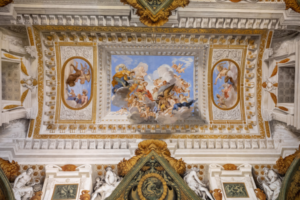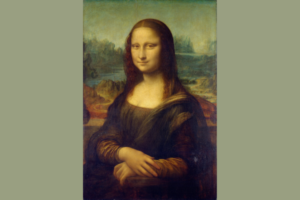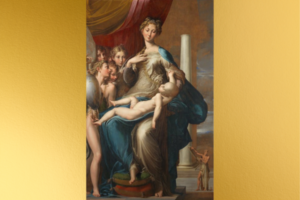Brief definition of Baroque.
The term “Baroque” refers to a European cultural and artistic movement that spanned from the late 16th century to the mid-18th century. Characterized by ornate detail, elaborate ornamentation, and a dramatic interplay of light and shadow, the Baroque movement sought to evoke strong emotions and captivate the viewer’s senses. It emerged as a means to counter the simplicity and quietness of the Renaissance art and to serve as a visual representation of the counter-reformation and the renewed Catholic Church’s mission.
The Italian Baroque, in particular, holds a distinguished place within this broader movement. Italy, often considered the cradle of the Renaissance, played a pivotal role in shaping the Baroque’s contours, pushing the boundaries of artistic expression.
As the birthplace of numerous renowned Baroque artists and monumental artworks, Italy’s contribution served as an influential force in the global art scene. Its art was not just about beauty; it was a profound mix of emotion, drama, and spirituality, creating a dynamic that resonated deeply with viewers, both then and now.
Through the masterpieces of the Italian Baroque, we witness the synthesis of meticulous craftsmanship and profound emotion, setting a gold standard for artistry across the world.
Emergence and Origins of Baroque in Italy
The roots of the Baroque in Italy can be traced back to the late 16th century, a period of religious, political, and cultural upheaval. With the Protestant Reformation challenging the dominance of the Catholic Church, there was an intense desire for the Church to reaffirm its spiritual and temporal authority. This urge to restore Catholicism’s prominence and counteract the minimalist tendencies of Protestant aesthetics spurred the emergence of the Baroque as a robust artistic response.
The Council of Trent, held between 1545 and 1563, played a pivotal role in defining the Church’s stance against the challenges of Protestantism. It became evident that art would be a powerful medium to communicate this renewed religious fervor. Consequently, artists were encouraged to create works that not only showcased religious themes but did so with a heightened emotional intensity and vigor.
Key Historical and Cultural Events that Influenced Baroque Art in Italy
In Italy, the transition from the Renaissance to the Baroque was influenced by more than just religious factors. The continuous shifts of political power, the rise and fall of city-states, and the patronage of influential families like the Medici in Florence and the Borghese in Rome played essential roles in shaping the direction of Baroque art.
Moreover, Italy’s unique position as a crossroads of Mediterranean cultures meant it was exposed to a myriad of influences. The incursions of the Spanish, the influence of Northern European art, and the ongoing connections with the Islamic world brought a diversity of ideas and techniques that enriched the Italian artistic palette.
Characteristics of the Italian Baroque
At the heart of the Italian Baroque was a drive to evoke powerful emotional responses from the viewer. This was achieved through several distinctive characteristics:
Drama and Intensity: Unlike the restrained and balanced compositions of the Renaissance, Baroque artists embraced dynamic scenes, filled with movement and energy. This drama was heightened by the intense contrasts of light and shadow.
Chiaroscuro: This technique, which means “light-dark” in Italian, was employed to give depth to figures and objects. By manipulating light and shadow, artists like Caravaggio added a three-dimensional quality to their paintings, drawing the viewer into the depths of the scene.
Ornate Detailing: The artworks were often rich in intricate details, from the swirls of heavenly clouds to the meticulous rendering of fabrics and textures.
Exaggerated Motion: Whether in paintings or sculptures, there was an emphasis on movement. Flowing draperies, twisting bodies, and cascading elements added a kinetic energy to the artworks.
Grand Scale: Many Baroque works, especially in architecture and sculpture, were monumental in scale, aiming to awe and inspire the viewer.
Through these characteristics, the Italian Baroque artist didn’t just present a scene; they invited the viewer to experience it viscerally, making the art an immersive, emotional journey.
Emphasizing Drama and Emotion: A Deep Dive into the Canvas
One of the hallmarks of the Baroque era, and especially the Italian Baroque, is the profound emphasis on drama and emotion. Rather than simply illustrating a scene, artists of this period endeavored to capture the very soul of their subjects and draw the viewer into a narrative filled with passion, tension, and movement.
How Drama and Emotion Were Captured on Canvas
Artists delved deep into the human psyche, presenting raw emotions such as ecstasy, sorrow, and passion. Their subjects were often caught in moments of action or deep contemplation, faces contorted with emotion or illuminated with divine light. This emotional intensity was further magnified by the settings and backdrops, which ranged from the tumultuous heavens to shadowy, intimate interiors.
Use of Light and Shadow (Chiaroscuro) to Create Depth and Motion
Chiaroscuro was not just a technique; it was a tool for storytelling. By manipulating light and shadow, artists could highlight certain aspects of a scene while leaving others in obscurity. This play of light added depth to their subjects, making them pop out of the canvas and emphasizing the three-dimensionality of the scenes. Caravaggio, for instance, mastered this technique, using it to spotlight his subjects and create dramatic contrasts that mirrored the emotional turmoil of his narratives.
Composition and Exaggerated Figures: Dynamic and Theatrical Representations
Baroque artists often strayed from the balanced and harmonious compositions of the Renaissance. Instead, they chose asymmetry, presenting figures that almost seemed to spill out of the canvas. The exaggerated forms, from elongated limbs to twisting torsos, added a theatrical flair to the artworks. This dynamism gave the viewer a sense of ongoing motion, as if they had captured a single, charged moment in time.
Pioneering Artists and their Iconic Works
The Italian Baroque was blessed with a pantheon of extraordinary artists, each bringing their unique touch to this grand artistic movement:
Caravaggio: Often dubbed the “bad boy” of the Baroque, Caravaggio’s works are known for their stark realism and dramatic use of light and shadow. His “Judith Beheading Holofernes” is a prime example of his ability to merge brutality with beauty, capturing the precise moment of violent action.
Gian Lorenzo Bernini: While renowned for his sculptural works, Bernini also dabbled in painting. His sculptures, like the “Ecstasy of Saint Teresa,” encapsulate the passionate spirituality of the era, with figures caught in moments of divine rapture.
Annibale Carracci: A proponent of the classical approach to Baroque, Carracci’s works, such as “The Loves of the Gods” in the Farnese Gallery, showcase a harmonious blend of Renaissance classicism with Baroque dynamism.
These artists, among others, paved the way for the Baroque to flourish, leaving a legacy that still resonates in the art world today.
Titans of the Italian Baroque: Their Contributions and Legacies
The Italian Baroque was not just a period but a canvas of interwoven narratives, championed by titanic figures who shaped the course of art history. Their profound influence remains palpable, not just in their masterpieces but in the myriad ways they transformed the essence of artistic expression.
Caravaggio and His Impact on Baroque Painting
Michelangelo Merisi da Caravaggio was, arguably, one of the most revolutionary artists of his time. Rejecting the idealized versions of subjects that many of his contemporaries portrayed, Caravaggio chose realism. He presented Biblical and mythological figures as ordinary people, often drawing from the streets for his models. His pioneering use of chiaroscuro – the stark contrasts between light and dark – became a defining feature of Baroque painting. This dramatic illumination imbued his works, such as “The Calling of Saint Matthew” or “The Supper at Emmaus,” with an intense, almost theatrical quality. In doing so, Caravaggio did not merely depict scenes; he created emotional experiences.
Gian Lorenzo Bernini and Sculpture
While Caravaggio’s canvas pulsated with life, Gian Lorenzo Bernini’s sculptures seemed to breathe. Bernini transformed cold marble into fluid forms, capturing the essence of human emotion and divine ecstasy. His ability to depict the intricate details, from the soft folds of fabric to the delicate play of flesh against light, set him apart. One of his most iconic works, “The Ecstasy of Saint Teresa,” encapsulates the fervor of the Baroque, where Saint Teresa’s spiritual rapture is tangibly conveyed through the masterful chiseling of marble. Bernini’s genius lay not just in his craftsmanship but in his ability to make the inanimate resonate with life and passion.
Annibale Carracci and the Emergence of the Academy of Drawings
While Caravaggio and Bernini were redefining art, Annibale Carracci was pioneering its pedagogy. Recognizing the need for a structured approach to artistic training, Carracci co-founded the Academy of the Desiderosi in Bologna, which later became known as the Academy of the Progressives. This institution, one of the earliest of its kind, emphasized the importance of drawing from life and studying the masters of the past. Carracci’s emphasis on a harmonious blend of innovation and tradition, as evident in works like “The Assumption of the Virgin,” provided a counterpoint to Caravaggio’s radical realism and set the stage for the academic traditions that would shape European art for centuries.
Comparison with Other Baroque Styles
The Italian Baroque, while foundational, was just one facet of a larger, pan-European movement. In Spain, the Baroque took on a deeply religious tone, with artists like Diego Velázquez marrying realism with spiritual fervor. The Dutch Baroque, or the Dutch Golden Age, leaned towards the secular, capturing daily life’s nuances through artists like Johannes Vermeer. Meanwhile, the French Baroque, influenced by the likes of Nicolas Poussin, straddled the line between classical rigor and Baroque opulence.
Yet, at the heart of all these regional variations lay a shared ethos – a desire to evoke emotion, to captivate the viewer, and to redefine the boundaries of artistic expression. The Italian Baroque, with its titans and their monumental contributions, played a central role in this grand symphony of art.
The Italian Baroque in a Global Context: Interactions, Influences, and Enduring Legacies
As the Baroque movement swept across Europe, it morphed and adapted to the unique cultures, histories, and socio-political contexts of each region. While there were distinct national flavors, a web of influences connected these various Baroque styles. The Italian Baroque, given Italy’s historical significance in art, played a pivotal role in this intricate tapestry.
Differences and Similarities between the Italian Baroque and Other Baroque Styles
Italian vs. Spanish Baroque: The Italian Baroque, with its emphasis on drama and chiaroscuro, had parallels in the Spanish Baroque, especially in the works of artists like Diego Velázquez. However, the Spanish style often had a more austere, somber undertone, reflecting the deep religiosity of the Counter-Reformation in Spain. This contrasted with the more exuberant and often opulent Italian Baroque.
Italian vs. Dutch Baroque: The Dutch Golden Age or Dutch Baroque was markedly different. While Italian Baroque was often centered on religious and mythological themes, the Dutch artists like Vermeer or Rembrandt focused more on domestic scenes, portraits, and landscapes, reflecting the prosperity and merchant culture of the Dutch Republic. However, the emphasis on realism and the play of light and shadow were common threads.
Mutual Influences between Different Regions
Trade, travel, and the rise of art academies facilitated a rich exchange of ideas across Europe. Spanish artists were deeply influenced by Caravaggio’s dramatic use of light, which can be seen in the works of Jusepe de Ribera. Conversely, the Italian Baroque was influenced by the rich colors and emotive brushwork of Spanish artists like El Greco.
Dutch genre painting and their pioneering work in still life and landscapes also made their way to Italy and influenced artists to explore beyond traditional religious themes. Similarly, the technical prowess of Dutch masters in capturing minute details was something that was keenly studied in Italy.
Impact and Legacy of the Italian Baroque
The Italian Baroque set a benchmark in artistic innovation. Its emphasis on emotion, the dramatic interplay of light and shadow, and the sheer scale and grandeur of its compositions redefined the boundaries of art. Its legacy can be seen in the Rococo’s ornate styles that succeeded it and even in the dramatic compositions of Romanticism.
Furthermore, the Italian Baroque artists, through their works, teachings, and academies, laid the groundwork for systematic artistic training. This not only shaped subsequent generations of artists in Italy but also set the template for art education across Europe.
In essence, while the Baroque styles varied across regions, they all shared a common aim: to evoke profound emotion and to make art an immersive experience. The Italian Baroque, with its monumental figures and their masterpieces, was at the heart of this endeavor, leaving a legacy that continues to inspire and captivate.
Echoes of the Italian Baroque: Enduring Influence and the Nexus with Modern Culture
The seismic waves of the Italian Baroque movement were felt not just in the 17th century but continue to reverberate through the corridors of time, influencing art, culture, and even tourism. As the heartland of the Renaissance, Italy’s transition into the Baroque era was both momentous and transformative, laying the groundwork for many artistic movements that would follow.
Influence on Subsequent Art, Both Within and Outside Italy
Rococo: Emerging in France during the late Baroque period, the Rococo was seen as a more playful, ornate offshoot of the Baroque. While it emphasized lighter themes and pastel colors, the roots of its drama and dynamism can be traced back to the Italian Baroque.
Neoclassicism: While Neoclassicism sought to revive the ideals of classical antiquity, artists like Jacques-Louis David were deeply influenced by the techniques and emotional depth of Baroque artists, merging them with the order and symmetry of ancient art.
Romanticism: The Romantic movement, with its focus on intense emotion, drew heavily from the drama and dynamism of the Italian Baroque. The swirling compositions and emotive characters in works by artists like Delacroix echo the legacy of the Baroque’s emotional intensity.
Beyond Europe: The influence of the Italian Baroque transcended European borders. In Latin America, for instance, Baroque ideals merged with indigenous influences, creating a unique blend evident in architecture, painting, and sculpture.
Preservation and Display of Works: A Cornerstone of Contemporary Culture and Tourism
The Italian Baroque masterpieces are more than just artifacts from a bygone era; they are living testimonies to an age of unprecedented artistic fervor. Their preservation is a testament to Italy’s commitment to its rich cultural heritage.
Museums and Galleries: Institutions like the Uffizi Gallery in Florence, the Vatican Museums in Rome, and the Borghese Gallery house some of the most iconic Baroque works. These institutions not only preserve the art but also contextualize it, allowing visitors to journey through time and experience the Baroque era’s grandeur.
Tourism: The allure of the Italian Baroque draws millions of tourists to Italy annually. Beyond the major cities, towns like Lecce in southern Italy, often dubbed the ‘Florence of the Baroque,’ showcase the style’s architectural wonders, attracting scholars, enthusiasts, and tourists alike.
Cultural Events: Festivals, exhibitions, and workshops centered around the Baroque are regular features in Italy’s cultural calendar. They serve to educate, celebrate, and perpetuate the profound influence of this era.
In sum, the Italian Baroque’s tentacles stretch far beyond the canvases and sculptures of the 17th century. It continues to be a wellspring of inspiration, a magnet for global tourism, and an integral thread in the rich tapestry of Italian culture and heritage.
The Italian Baroque: A Timeless Testament to Artistic Brilliance
The vast expanse of art history is dotted with movements and epochs, each leaving its indelible mark on the canvas of time. Yet, even within such a rich tapestry, the Italian Baroque stands out, not merely as a period of artistic evolution but as a revolutionary shift in how emotion, drama, and detail could be portrayed. Its opulence, depth, and sheer dynamism have left a legacy that is hard to overstate.
Art, at its core, is a reflection of humanity – its passions, its turmoil, its aspirations. The Italian Baroque, with its grandeur and its intimacy, its theatricality and its realism, captured the essence of the human experience in a manner few other movements have. It challenged the conventions of its time, pushing the boundaries of what was possible on canvas and in stone. And in doing so, it redefined the very paradigms of artistic expression.
But to truly appreciate the Italian Baroque’s profundity, reading about it, while informative, is only the starting point. Art needs to be experienced. The play of light and shadow, the intricacy of a brushstroke, the emotion etched into a piece of marble – these are things that resonate on a deeply personal level when seen firsthand.
So, whether you’re an art enthusiast, a curious traveler, or someone simply looking to understand more about our shared cultural heritage, I urge you to delve deeper. Explore books, documentaries, and lectures on the subject. But most importantly, whenever the world permits, visit the museums and galleries that house these masterpieces. Walk the corridors of the Uffizi, stand in awe at the Vatican Museums, or lose yourself in the lesser-known yet equally mesmerizing collections scattered throughout Italy.
The Italian Baroque, with its rich tapestry of stories, characters, and emotions, awaits your discovery. And in exploring it, you’ll not just be witnessing art – you’ll be stepping into a world of drama, passion, and unparalleled genius. A world that, even centuries later, has the power to inspire, move, and captivate.



